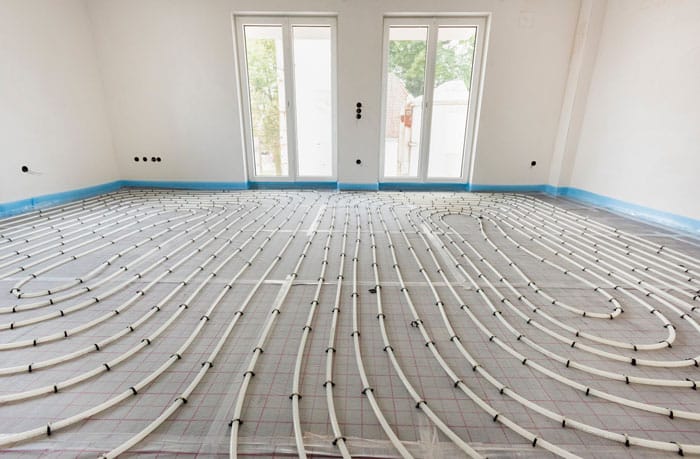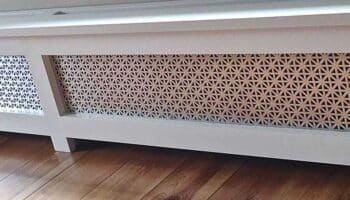We've independently reviewed this article to make sure it's as accurate as we can make it.
To find out more about our article creation and review process, check out our editorial guidelines.
Are you sitting in your great room with those beautiful cathedral ceilings shivering? Does your burning question of the hour have something to do with how to heat a room with high ceilings?

Many people get caught up in the design aspects of rooms with high ceilings but fail to realize they are difficult to keep warm.
So what can you do?
There are several tips for heating a room with high ceilings. Some are free, some for budget-minded, and some quite expensive. From simply keeping window coverings open during the day and letting the sun do some of the work, to installing radiant heating. And a few in between.
If you’re cold right now, wrap up in a blanket then keep reading. I’ll cover everything you need to know about heating that chilly room.
How to Heat a Room with High Ceilings
As mentioned above, there are several options available to you. Let me start with the free and inexpensive.
1. Make Use of Natural Light
When the sun shines in your windows and into your home it causes something called solar heat gain. This is when the temperature in your home rises because of solar or short-wave radiation.
Homes in the northern hemisphere tend to be built with a high thermal mass because for much of the year they need heat.
Thermal mass is—in part—the ability of a structure to absorb and retain heat.
The heat from the sun is free, so use it. At whatever part of the day the sun shines in your window, pull back or up your window coverings. But only do this in the heating season! Heat will build up in your home and stay there for a period of time, which is dependent on the amount of thermal mass your home has.
2. Light the Fireplace
If you have a fireplace in your home, make use of it too. Don’t wait until it gets unbearably cold before starting it. The longer the fire burns, whether wood, gas, or is electrically fueled, the longer it runs the more heat will build up.

3. Turn the Furnace Fan from AUTO to ON
Most people have their furnace fan on auto, and it just cycles on and off with the furnace or AC. However, if you turn it to ON, it will run 24/7.
There are huge advantages to setting your fan to ON but don’t be too hasty in doing so. Because depending on the age and type of your furnace, your utility bill could skyrocket.
If your furnace is newer, it may have a more energy-efficient blower motor, but don’t assume that. If you have a two-stage furnace, your blower is designed with running the fan all the time in mind, so this is a great option for you.
You know what a fan does. It circulates air through your home, whether warm or cool. And it will continue to do that even when the furnace—or air conditioner—isn’t calling for heat or cold.
So take advantage of the warm air that’s in the room and move it around.
The problem with high ceilings is that hot air rises. So you have a situation where you’re down there on the floor level and your warm air is 12 or more feet above. Not really helpful, is it?
When your furnace cycles off and your fan with it, there may be a 15-minute break before it starts up again. During those 15 minutes when it’s off, the air in your home is stagnant and has time to separate—the hot air moves to the ceiling, and the cold air drops to the floor. Leave the fan on and don’t provide that opportunity.
Just be aware that the design and layout of the supply and return vents in the room will have an impact on this strategy.
4. Reverse the Direction of Your Ceiling Fan
Many vaulted ceilings have a ceiling fan. If yours does, you should be changing its direction seasonally.

During the heating months, you want to adjust that fan so that it’s rotating in a clockwise direction. You also want to have it set to low speed. This will help redistribute warm and cold air by pulling cool air up and pushing that warm air that you desperately want back down towards you.
Just remember to reverse this when the cooling season starts.
5. Adjust Unused Supply Vents
If you have any unused rooms upstairs, partially closing your supply vents may help. Since you’re not using the rooms, it makes no sense to push more warm air into them when you really need it downstairs. Warm air is heading up there all by itself.
Partially closing those vents will redistribute some of your air. Just be sure not to go too far and close them entirely. You’ll do that at the cost of your HVAC system.
Completely closing off vents will cause a high-pressure build-up. Your system is created to move air throughout the home, and equal amounts need to be pulled in through your return vents and pushed out through your supply vents.
6. Consider Getting a Space Heater
You have a lot of options here, many of them energy efficient. And they can be a great way to supplement your heat where needed.
Here are the steps to correctly size a space heater for your room.
| Measure Your Room | Calculate length x width for square footage. |
| Calculate Wattage | You should estimate 10 watts for every square foot of space, then multiply by 10. For example, a room with 200 Sq Ft will need 2,000 watts. |
| Convert Wattage to BTUs | 1 watt equals 3.41 BTUs so multiply wattage x 3.41. Example: 2,000 watts x 3.41 = 6,820 BTUs |
7. Underfloor Heating
This really doesn’t fall into the budget category, but it is the best way to add heat to individual rooms.
It’s all fantastic for rooms with high ceilings – as the heat is generated across the room you can feel it much better. Heat from a radiator is more prone to going up more than around the room.
Since this type of heating is added under the floor, the best time to consider it is when you’re doing a reno of having new flooring put down.

Cables are laid that generate heat either electrically or hydroponically. The beauty of this is you can concentrate heat exactly where you need/want it. The process radiates heat up through the floor where it’s absorbed into objects. Like you. Forced air heats the air and then you in turn feel warm.
Will High Ceilings Affect Your Heating Bills?
Yes. Probably.
Unless you’re fortunate enough to have a room with lots of natural sunlight—and the sun actually shines where you are during the winter—heating that room is going to cost you something. Or if adjusting your upstairs vents is enough to bring you warmth downstairs.
- Lighting the fireplace will cost you in fuel, whether it’s wood, gas, or electricity
- Keeping the furnace fan on will cost you electricity
- Leaving your ceiling fan on in the winter will cost you electricity
- You might need to buy a space heater and running it will cost even more
- Radiant heating will be the most expensive option to purchase and install. And you’ll likely need to replace your flooring as well.
Note that keeping your furnace fan running constantly could make things uncomfortable, even if the air is warmer. The moisture on the skin evaporates with the moving air, which can make you feel more chilly as that moisture has a layer of heat when it’s on your skin.
In the end, you need to decide on the price you pay for your comfort. Maybe you’ll be like a Mastercard commercial. Finally feeling warm in my high-ceilinged room . . . priceless!
Conclusion
If you’ve recently moved into a home with high or vaulted ceilings, you may not have been prepared for the chill. But at least there are some alternatives when it comes to warming things up.
Fortunately, some of them are free or at least relatively inexpensive. But yes, you can expect to pay some extra money to heat the room.
Hopefully, these tips have proved useful!
Thanks for reading. Why not check out our related posts below? Maybe we can help you with something else.







